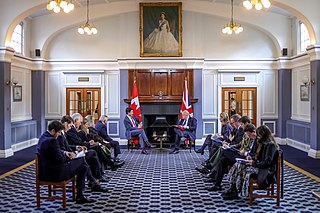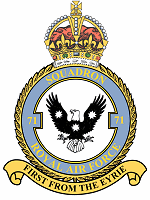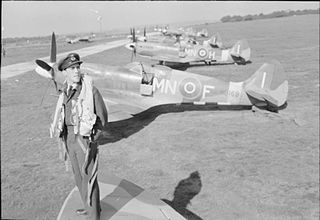
The Royal Flying Corps (RFC) was the air arm of the British Army before and during the First World War until it merged with the Royal Naval Air Service on 1 April 1918 to form the Royal Air Force. During the early part of the war, the RFC supported the British Army by artillery co-operation and photographic reconnaissance. This work gradually led RFC pilots into aerial battles with German pilots and later in the war included the strafing of enemy infantry and emplacements, the bombing of German military airfields and later the strategic bombing of German industrial and transport facilities.

The Royal Naval Air Service (RNAS) was the air arm of the Royal Navy, under the direction of the Admiralty's Air Department, and existed formally from 1 July 1914 to 1 April 1918, when it was merged with the British Army's Royal Flying Corps to form the Royal Air Force (RAF), the world's first independent air force.

Royal Air Force Northolt or more simply RAF Northolt is a Royal Air Force station in South Ruislip, 2 nautical miles from Uxbridge in the London Borough of Hillingdon, western Greater London, England, approximately 6 mi (10 km) north of Heathrow Airport. As London VIP Airport, the station handles many private civil flights in addition to Air Force flights.

Royal Air Force Wittering or more simply RAF Wittering is a Royal Air Force station within the unitary authority area of Peterborough, Cambridgeshire and the unitary authority area of North Northamptonshire. Although Stamford in Lincolnshire is the nearest town, the runways of RAF Wittering cross the boundary between Cambridgeshire and Northamptonshire.

Air Commodore Arthur Henry Cobby, was an Australian military aviator. He was the leading fighter ace of the Australian Flying Corps (AFC) during World War I, despite seeing active service for less than a year.
Castle Bromwich Aerodrome was an early airfield, situated to the north of Castle Bromwich in the West Midlands of England. The site now falls within the City of Birmingham.
Royal Air Force Drem, or more simply RAF Drem, is a former Royal Air Force station, just north of the village of Drem in East Lothian, Scotland. The motto of the station was Exiit Hinc Lumen which means "Light has departed from this place".
Royal Air Force Montrose or more simply RAF Montrose is a former Royal Air Force station in Forfarshire in Scotland. It became the first operational military aerodrome to be established in the United Kingdom on 26 February 1913.

No. 71 Squadron was a Royal Air Force aircraft squadron. The number has been used three times: once by the Royal Flying Corps for an Australian Flying Corps squadron; in the Second World War as the first of three Eagle Squadrons; and post-war as a fighter-bomber unit under the command of Royal Air Force Germany.
Royal Air Force Throwley or more simply RAF Throwley is a former Royal Air Force (RAF) installation located 1.2 miles (1.9 km) south of Throwley, Kent and 7 miles (11 km) north of Ashford, Kent. The installation was also used by the Royal Flying Corps was previously called Throwley Aerodrome before being taken over the RAF during April 1918 and renamed to its current name.
A list of airfields of the Royal Flying Corps.

Royal Air Force Wrexham, or more simply RAF Wrexham, is a former Royal Air Force station at Borras, on the outskirts of Wrexham, Wales and north-east of the city centre.

Royal Air Force Lympne or more simply RAF Lympne is a former Royal Air Force satellite station in Kent used during the First and Second World Wars. It was opened in 1916 by the Royal Flying Corps as an acceptance point for aircraft being delivered to, and returned from, France. It was later designated as a "First Class Landing Ground". In 1919, the airfield was turned over to civil use as Lympne Airport, serving until 1939 when it was requisitioned by the Fleet Air Arm as HMS Buzzard, later being renamed HMS Daedalus II.

Royal Air Force Harlaxton or more simply RAF Harlaxton is a former Royal Air Force station near the village of Harlaxton, 3 mi (4.8 km) south west of Grantham, Lincolnshire, England. The airfield was located in a triangle of flat fields midway between Harlaxton Manor and the nearby village of Stroxton.

Saint-Inglevert Airfield is a general aviation airfield at Saint-Inglevert, Pas-de-Calais, France. In the First World War an airfield was established near Saint-Inglevert by the Royal Flying Corps, later passing to the Royal Air Force on formation and thus becoming RAF Saint Inglevert.

Lieutenant Pruett Mullens Dennett was a World War I British flying ace. He was credited with ten aerial victories, the last occurring on the day he was killed in combat.
RAF Lilbourne is a former Royal Air Force station which was located 5.2 miles (8.4 km) south of Lutterworth, Leicestershire, England.
Leadenham Aerodrome was a Royal Flying Corps First World War airfield at Leadenham, Lincolnshire, England. It became RAF Leadenham in April 1918 until it closed in 1919.

Bramham Moor Aerodrome,, was a First World War era military airfield near to the village of Bramham, West Yorkshire, England. Initially a Royal Flying Corps site, on the formation of the RAF, its name was officially changed to RAF Tadcaster, however, the unit was still referred to as Bramham, or Bramham Moor, even in official documents. The base was used between March 1916 and December 1919 by active aircraft squadrons, but was not closed down until April 1920. Bramham was originally used as a Home Defence station, due to the threat of Zeppelin attacks, but later, it was used primarily for preparing aircrew for front line operations. It did not see re-use as an airfield during the Second World War, however, vehicles were parked on the grassed runway areas to deter glider landings during the threat of invasion.












